The instruments and devices described here are self-contained interactive instruments that attach to small or large portable solar panels. Some of the designs have solar panels built in to them, while others are designed to attach to wearable devices. Many of these are based on simple logic circuits, while others use small AVR microprocessors to make sound. Although no batteries are used in these devices, some of the devices use supercapacitors for power buffering, particular for amplifiers in some of the instruments. Note that this site is being updated constantly. Some of these devices include video clips, soundfiles, and schematics. More are coming…
Eloe – White Edition (2020)
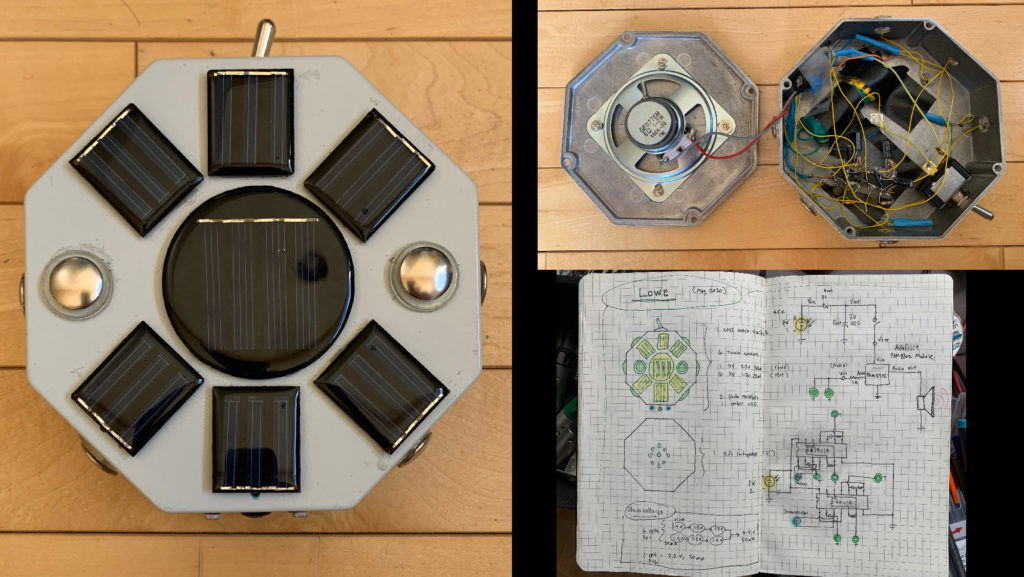
Materials:
• Custom 74c14 (2) logic synth circuit
• 2.5 watt amp (PM 8302 module)
• 3” 8 ohm speaker
• 6 touch channels
• 2 photocells
• Amber Led
• Octagonal steel box
• 7 PV panels
PV:
• 6x 1.5v 25 mA cells I series/parallel, creating 4.5v 50mA vSUP. Powers a 3v 50F supercap and the audio amp.
• 1x 2.5v 30mA cell powers the synth circuit – no buffering
Eloe, white edition, is a new instrument in a series that came out of the covid-19 moment. Being stuck indoors and unable to complete other project, and not having made a new instrument in a while, I began work on Eloe. The name comes from a reimagining of the name “Lowe,” which is the middle name of the late, great experimental synthesist, composer, and improvisor Richard Tietelbaum.
This instrument is contains two independent circuits: a custom synthesizer made from two hex Schmitt trigger chips (74C14), both of which have several oscillators that feed back into each other. They are directly powered by one 2.2 V PV module, with no buffering. The amplifier is separately powered by a 100 F 3 V super capacitor, which is charged by the other PV modules. This means that the amplification stage is more stable, and allows for performance in lower light conditions, which the synth itself is subject to the extreme voltages of the moment.
Aalborg (2017)
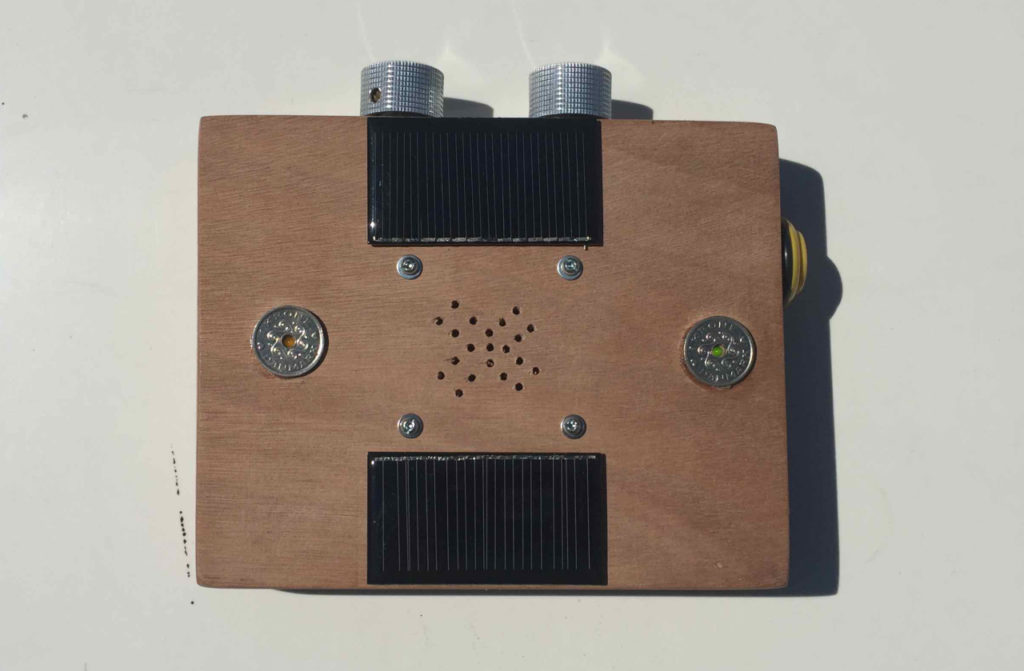
Materials:
• Custom 74c14 logic synth circuit
• 1 watt amp (386-based)
• 2” 8 ohm speaker
• 2 touch channels (kroner coins)
• 3 photocells
• 2 LEDs
• Power switch
• Cigar box
• 3 PV panels
PV:
• 2x 2 V in parallel, powering the logic chip synth circuit & 2 LEDs under the coins
• 1x 6 V powering two 2.7V 50F supercaps in series, which powers the amp
Aalborg is a four-oscillator noise synth based on a 74C14 hex inverter chip, and is built into a Cuban cigar box. It is named after Aalborg University in Copenhagen, from which I acquired the kroner coins that are used as touch sensors. It contains two touch sensors that turn on/off the sounds, a yellow button that changes the capacitor of one of the oscillators (and acts like an “octave” key, two knobs, and three photocells, all of which change various aspects of the oscillators pitch.
This is the first instrument in which the power amp and the synth circuit are powered by separate systems – one of which is buffered by a supercapacitor for better stability.
Crabby (2015)
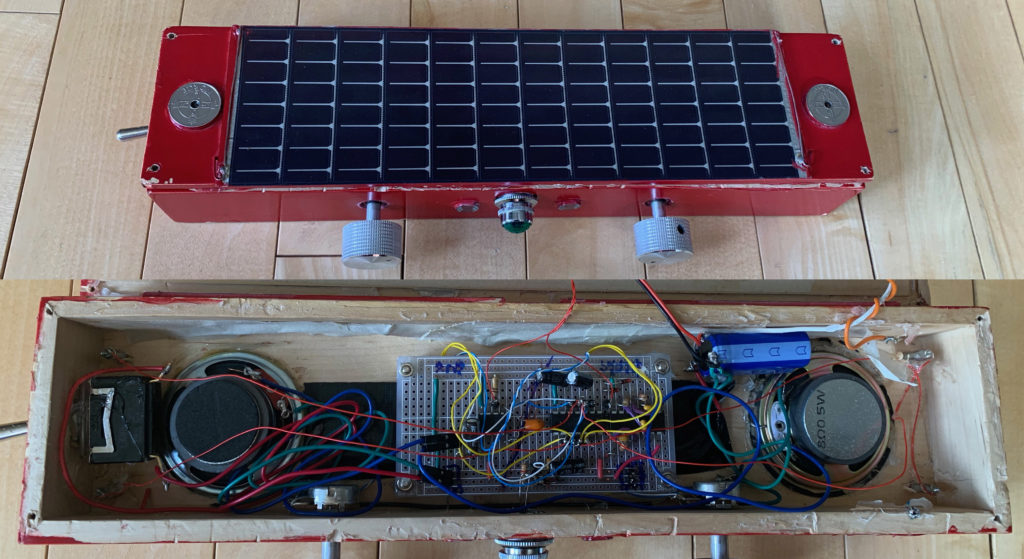
Crabby is a four-oscillator noise synth with two knobs for controlling frequency, two photocells for modulation, and six touch sensors for mixing/muxing the oscillators. It is built into a wooden, recycled Crabtree & Evelyn soap box. Like many of these instruments, this one is based on a 4093 quad NAND gate logic chip, and is amplified by two separate 1 watt amp/speaker pairs, one for two pairs of oscillators.
The Engine Room (2015)
[ video ]
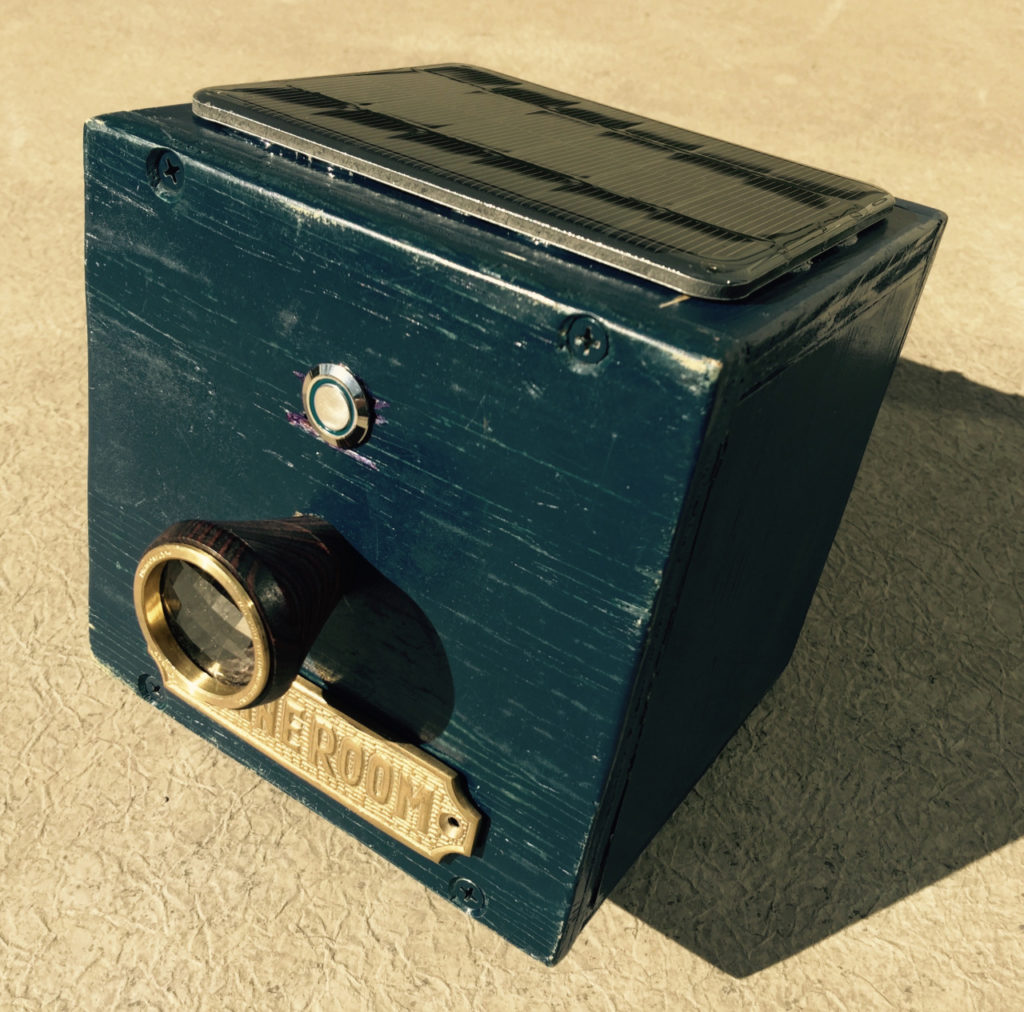
The Engine Room is a bit different from many of the devices here, as it isn’t really an instrument, and it isn’t based so much on the idea of variable-energy-as-expression. It’s really a kind of mysterious box with a eyepiece (peephole?) and two small speakers, created for and exhibited for a few years at the Burning Man Festival. The piece is powered by a large super capacitor which is charged by the solar panel mounted on top, and it designed to supply sustainable power for 24 hours a day. Pressing the button creates a randomized kaleidoscopic light and sound experience for 10 seconds. Here is a short video of it in action in Black Rock City, when it still had headphones (now there are two small speakers instead).
Jake & Lillytom (2014)
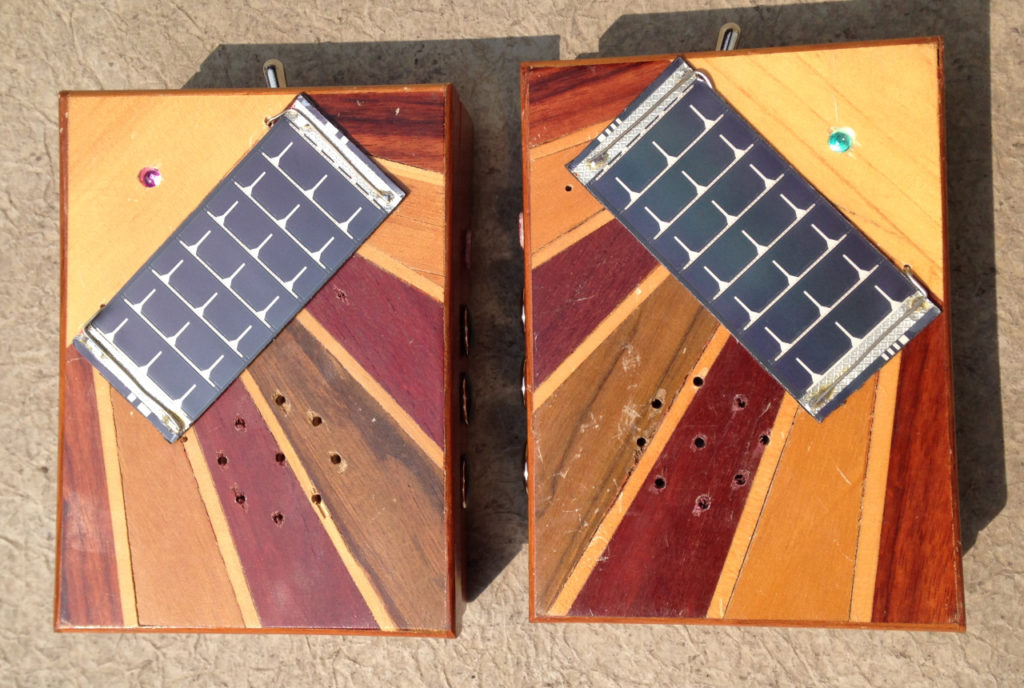
Jake and Lillytom are a pair of solar instruments with solar panels integrated into the wooden casing. This is the first series of instruments that called for an all-in-one approach, rather than having the solar panels be plugged in to the instrument. They are powered by a 1W amp/speaker and are mirror versions of each other, designed to be held one in each hand. The crackly nature of these instruments harkens back to the Cracklebox, an inspiration for certain.
Radio Flyer (2012)
[ video ]
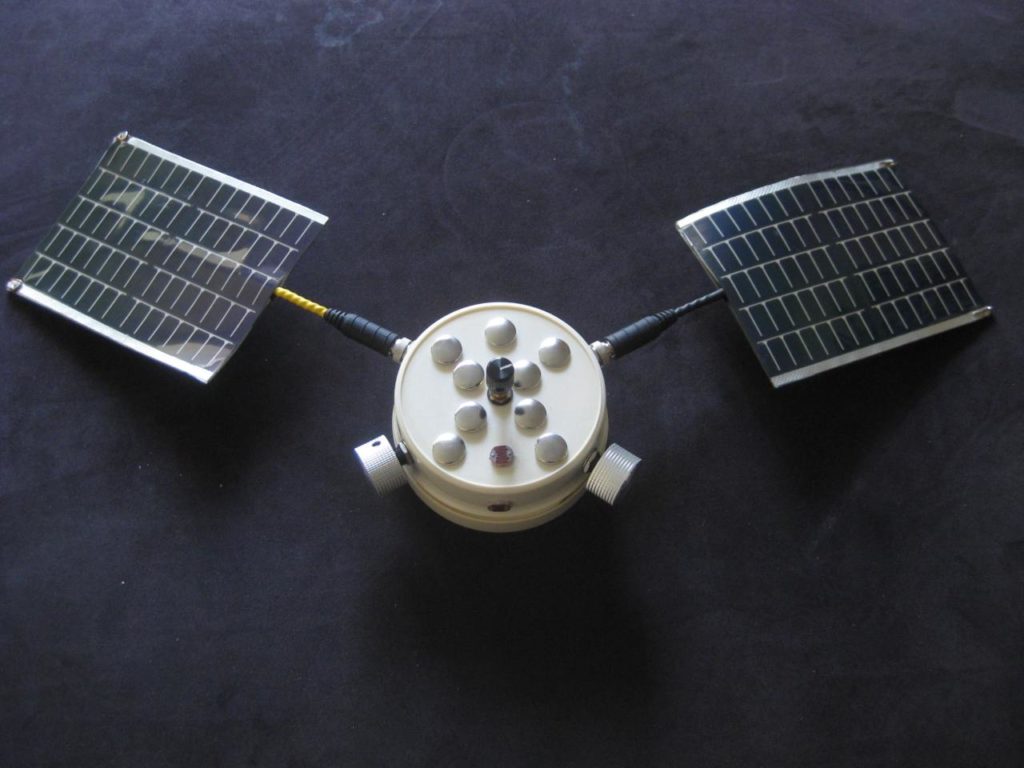
Radio Flyer is the first of what will hopefully be a series of handheld, solar-powered instruments that can communicate with each other over a wireless radio network, and can also broadcast their sounds over radio frequencies. It produces two-voice melodic patterns that can be adjusted in a variety of ways. The instrument is built into a recycled “Body Butter” container, and includes touch-keys for triggering sounds, two rotary controllers for changing pitch and tempo, photocells for modifying the patterns, and a volume pot. Since the device can be communicated with over a proprietary (XBee-based) radio network, this device can be “recoded”, and thus might become a kind of blank canvas for trying out different kinds of sound-making ideas.
Sadly, this instrument ceased functioning after a few years and is currently dead. Perhaps in time this project will be reinvigorated, but in the meantime, the research that went into this instrument was instrumental in the development of Coronium 3500 (Lucie’s Halo), which is described elsewhere.
Patrick (2011)
[ video ]

Patrick consists of an interactive noise circuit featuring four photocells and six small solar petals, built into a discarded piece of “bric-a-brac” that was found in a local thrift store, which used to be a candle-holder on a small gooseneck stand. The sound circuitry is based on a 4049 NAND logic gate with photocells that change the frequencies of the oscillators, which cross modulate each other, creating noise patterns. The solar petals are 150mW flexible solar strips, and together supply 9 volts at 100 mA. This device can be treated like an instrument, or can simply be exhibited as part of an installation.
Jazzy Joe (2010)
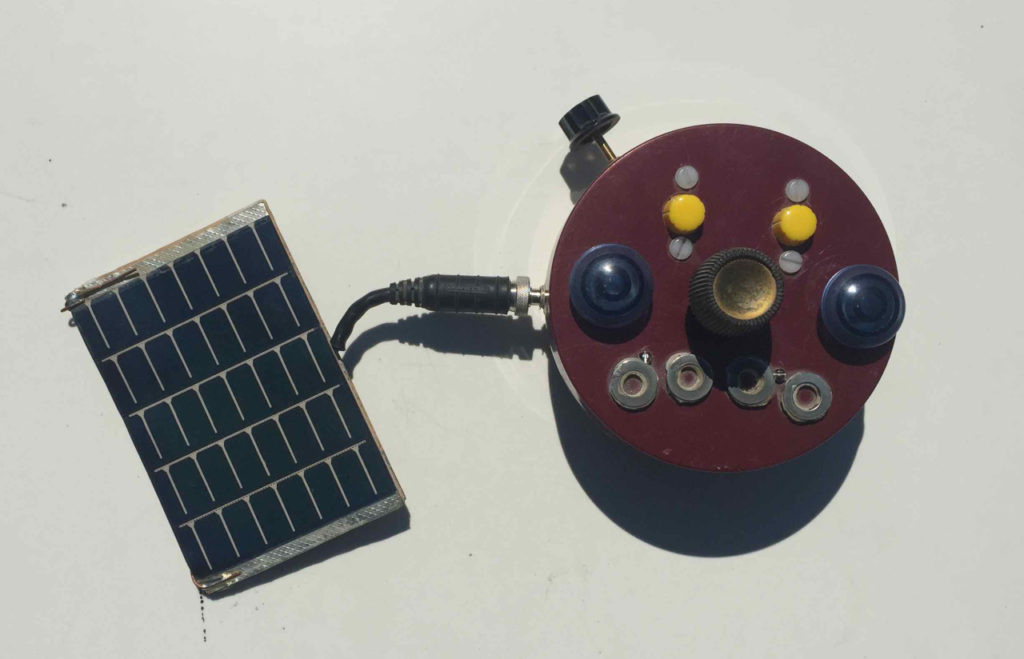
Jazzy Joe is a hybrid instrument consisting of two types of noise circuits in one device. One type is a modulated square-wave circuit based on the 4049 NAND gate, similar to some of the instruments below. The second type is based on the ATMEL microprocessor, and features a sine tone playing randomized melodic patterns. Combining these two sound sources in various ways results in some interesting sounds and textures. The sine tone’s base frequency can be played using the pot in the center, and the metal “keys” (touch sensors) are body contacts which turn the tones on and off. The two yellow buttons trigger components of the 4049-based sounds, and two photocells allow for manipulation of timbre.
Arcade Bells (2012)
[ video ]
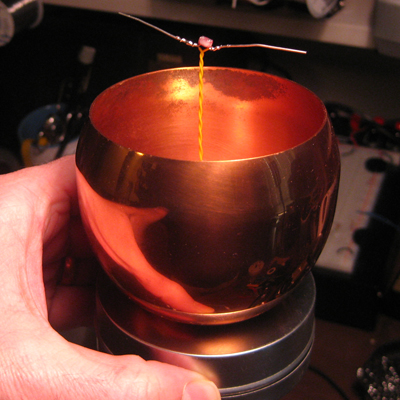
These are a set four devices that make video game-like 8-bit textures and patterns. The sound is generated by an ATMEL ATMega 368 chip, and recycled copper cups act as a speaker, driven by a transformer-powered piezoelectric driver. These devices change their speed depending on the amount of light that falls on the floating photocells, and their volume is based upon the amount of power they receive from the sun. Note that the sound-making software on the ATMEL chip has been changed several times since the inception of these instruments. Sadly, they were destroyed at the 2012 Burning Man Festival, being run over by an art car.
Verde (2010)
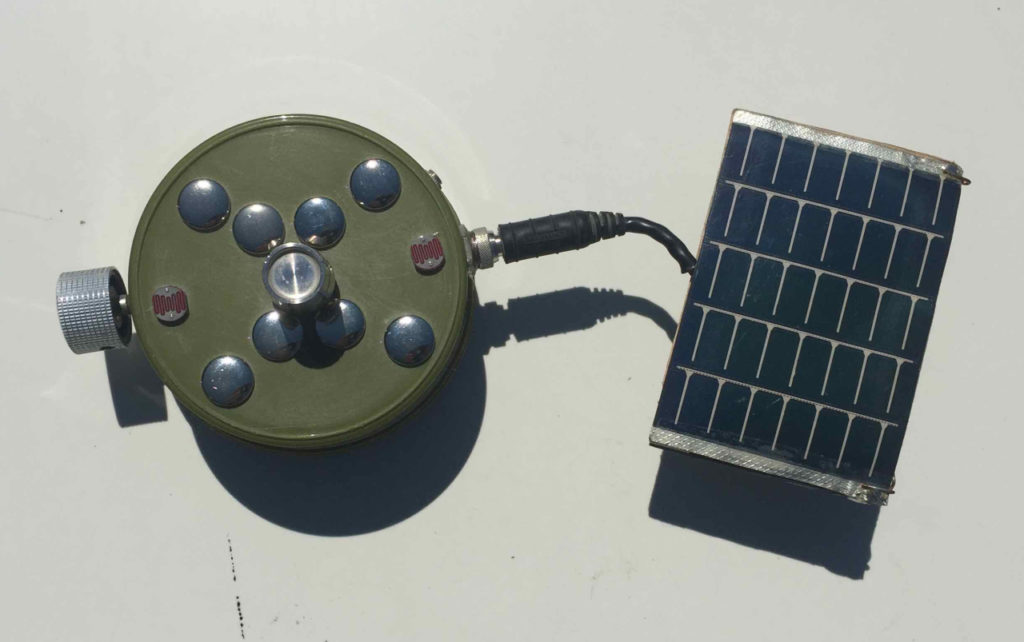
Verde is a four-oscillator noise synth made from a 4093 quad NAND gate logic chip, very similar to the instruments below, but built instead into a plastic (recycled) body butter container. It contains touch keys for triggering and mixing the oscillators, as well as photocells and one potentiometer (knob) that are able to modify the frequency of the oscillators, as well as a volume switch. Like many of the instruments below, it is designed to be powered by a small PV card, or a larger 5-watt solar panel. It is amplified by a 1W amp/speaker and also has a line output for amplifying through a larger PA system.
Fins of the Elements (2010)

These pieces, collectively called Fins of the Elements (2010) consists of four recycled aluminum flower pots, each with a pair of piezoelectric drivers which deliver soft clicking patterns into the sides of the structure. Each of the four pots generate two different patterns (and may occasionally squeak). They are completely self-contained, and are powered by a small PV strip mounted to the top of each device. There are also photocells which cause the devices to click faster if more light is present. Thus, the clicking becomes louder and more rapid as light levels increase. Together they create a kind of polyrhythmic micro-clicking texture, similar to (and inspired by) the sound of baseboard heating systems in winter as they heat up and cool down.
This is really a self-contained little sound art piece that works best in a very quiet space, and will work with standard gallery lighting, or can be hung hear a window. This piece was originally installed alongside photographs by artist Maria Whiteman at the FAB Gallery at the University of Alberta.
Bird (2009)

Bird is a hanging, mobile-like device that is able to turn freely, and responds to light wind and air movement due to the hanging streamers that surround it. In the center of the streamers (made from recycled 1/4″ leader tape) are four beeping sound devices, each with their own individual character. These four small devices contain their own individual array of small solar cells, which provide all power. As they turn, their angle to the sun also changes, allowing them to change their song constantly.
Goldie (2009)
[ video ]
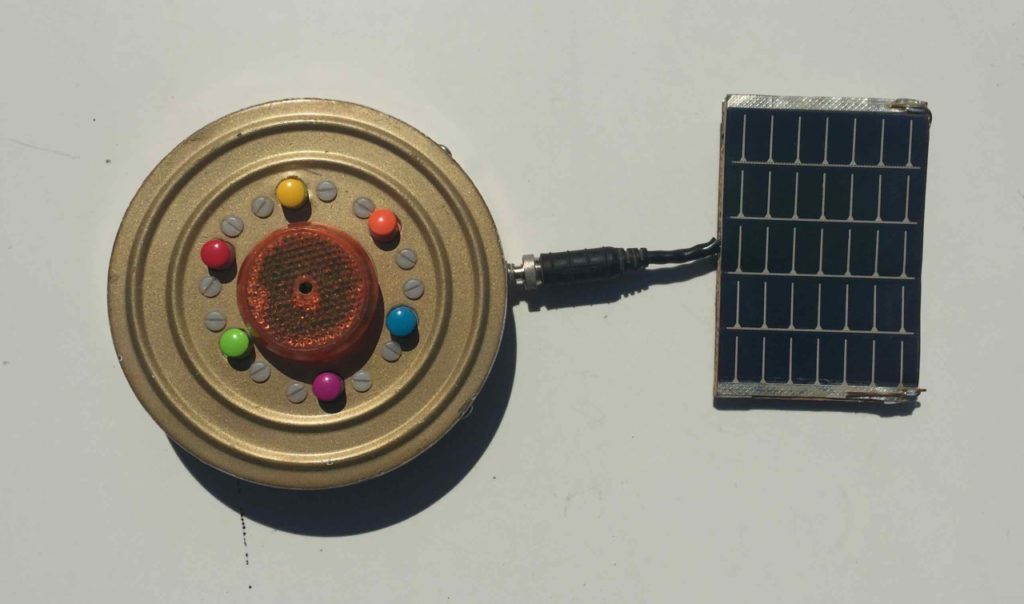
Goldie is another round handheld instrument, using simple logic chip synth circuits, metal coins (on the bottom) as touch sensors, which cause the instrument to become louder, as well as six colored buttons hacked off of an old bowling toy. Like the instruments below, this instrument responds directly to varying voltages from solar panels, and can be powered by small solar cards that hang from the bottom, as well as larger 5-watt solar panels. This instrument is a bit more “pitchy” and droney than many of the others, and has been useful as a sustaining voice when performing with other instruments.
Red Fly, Blue Fly, Green Fly (2008-09)
[ video ]
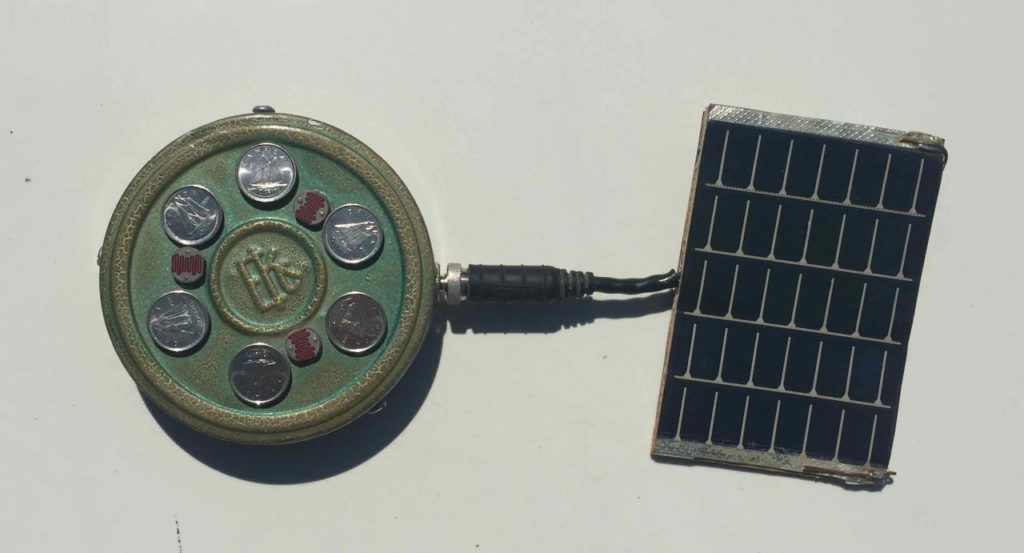
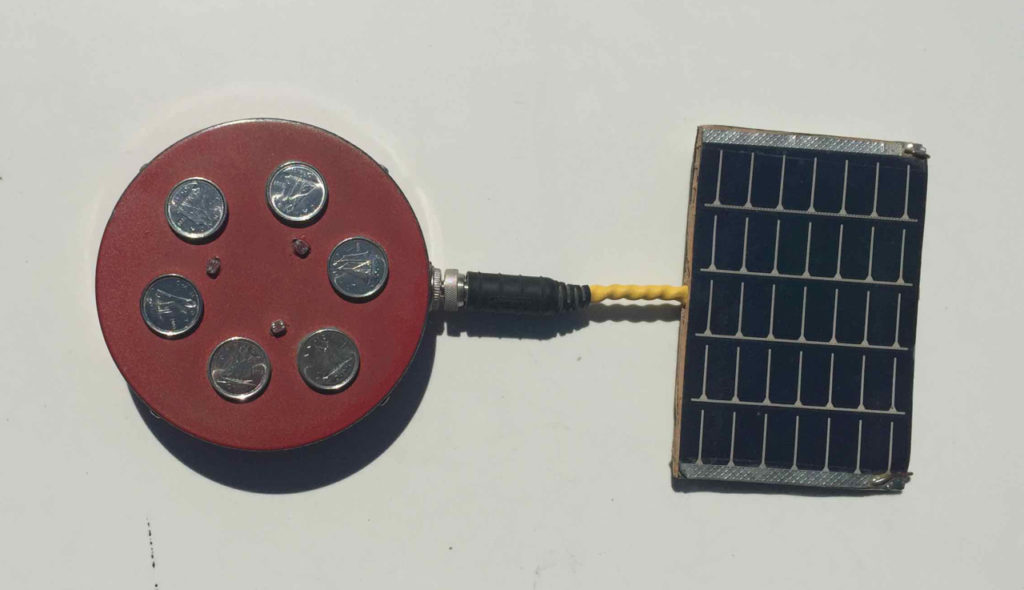
These “fly” instruments are a series of “noise disc” instruments: small, handheld devices consisting of twittery, squealy insect-like sounds created by simple logic chips. Like Caltrop below, these instruments use coins as touch sensors and photocells to modify the oscillator frequencies, the innards of which are stuffed into recycled film canisters. The player holds the instrument between the hands, using them to muffle the sound and change the nature of the sound through skin capacitance and light blockage. These are powered by small, index card sized solar panels which hang off of the instrument. They can also be plugged into larger 5-watt solar panels for louder operation.
These were perhaps the first really successful and fun instruments, and they now live permanently in storage in Reno, NV, where they get a chance to perform every year at the Burning Man Festival in Black Rock City, NV.
Puck (2008)
[ video ]
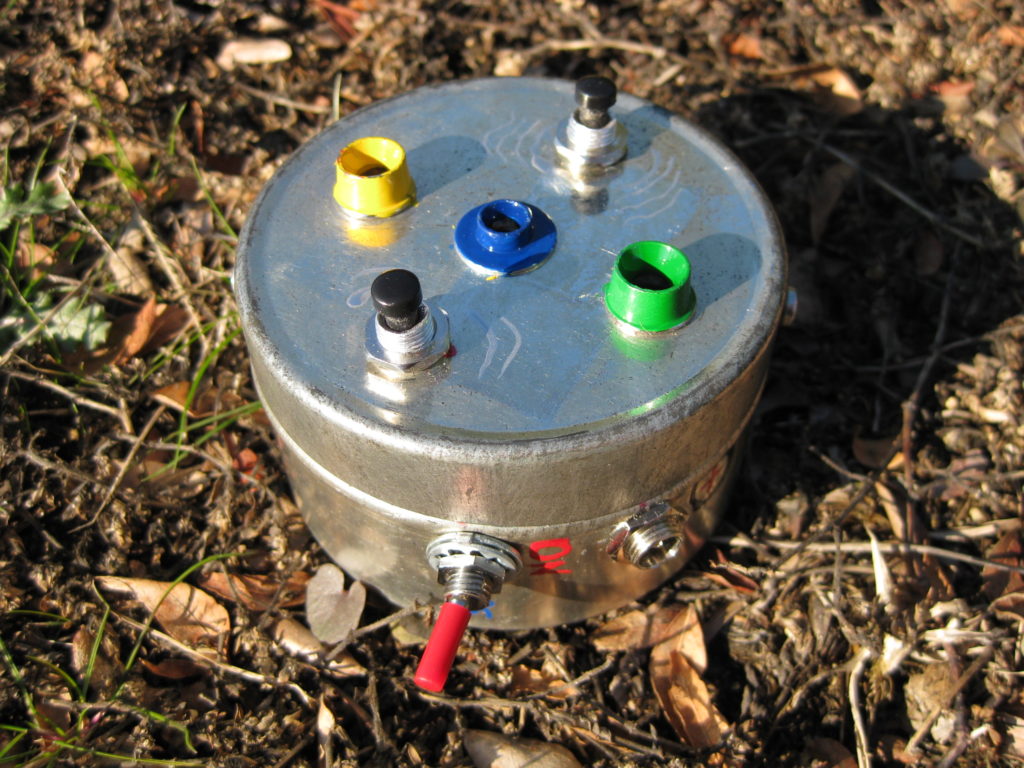
Puck is a bit of an anomaly, being the only instrument I’ve build which uses only buttons and no touch sensors. Because many of the instruments are designed to be played outside, and many have spent considerable time being played at the Burning Man Festival, which is extremely hot, dusty and inhospitable to electronics, touch sensors are better. The buttons are also a bit noisy. It is also the smallest instrument, made out of a very small film canister.
Weirdly, this instrument still functions as of 2020, and like Caltrop, it is contains a 2.1mm power input, designed to be powered by a 5-watt solar panel, but also can simply be plugged using a wall wart power supply.
Caltrop (2008)
[ video ]
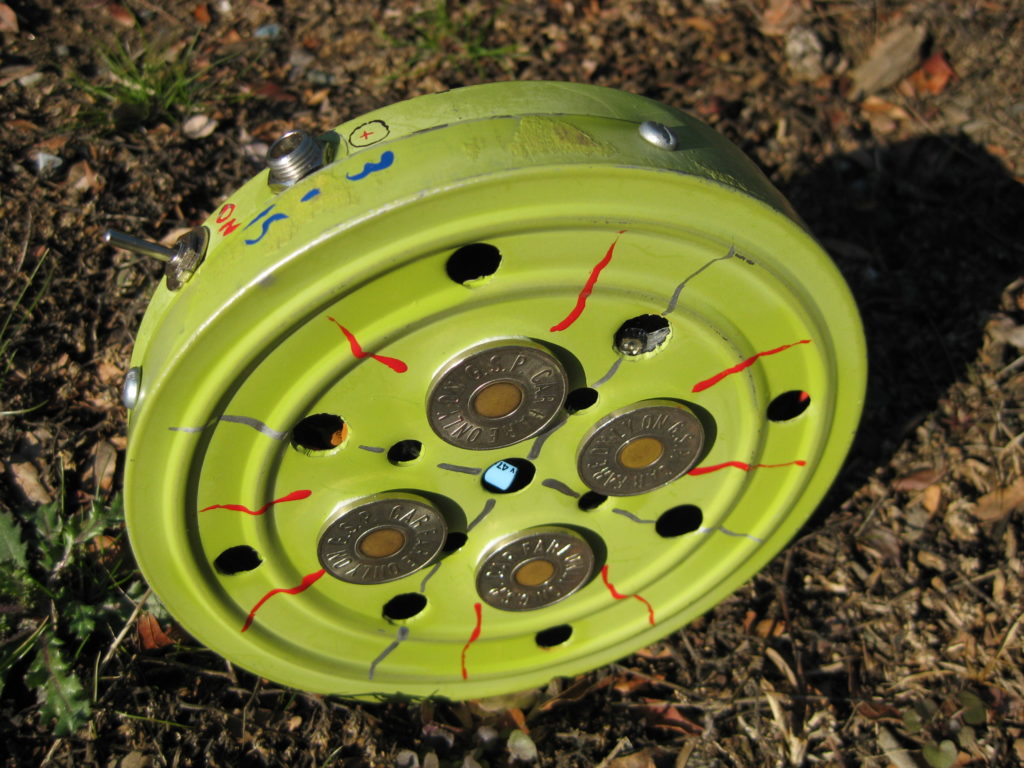
Caltrop was the very first instrument. It was made from a small film canister I acquired from a job working as an archivist and technical assistant for film composer Frank Lewin. The name comes from a comment made by Perry Cook, who said it looked like a land mine.
The instrument was designed to be attached to a 5-watt solar panel that I used to use for many of these early instruments. It features 8 touch sensors made from Garden State Parkway tokens, and includes a speaker on each side of the “coin.” It is designed to be played with the hands together, like a little squeeze box that doesn’t actually squeeze (inspired by one of Perry Cook’s instruments).
